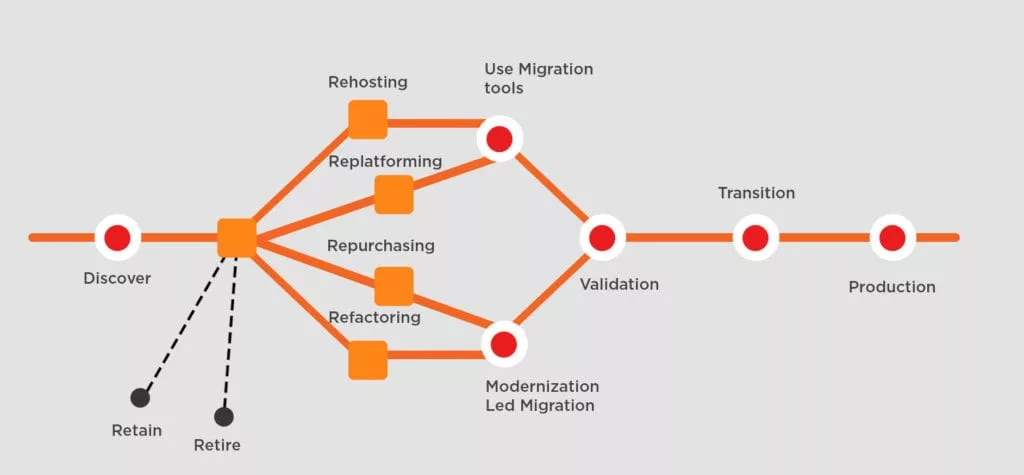Cloud Migration v/s Modernization: What to choose?
Many organizations depend on legacy applications at the core of their operations. However, ageing software should not derail your cloud strategy. With Windows Server 2008 and SQL Server 2008 both ending their support in June 2019 and January 2020 respectively, SourceFuse offers to confidently migrate your applications to the cloud. We are AWS Advanced Consulting partners with ‘Windows Workloads’ Competency in delivering support to our customers along with secure scalability in the cloud. By methodically assessing your software and applying business requirements, we can minimize disruption, reduce costs, and optimize speed. We can also re-architect, rehost, and apply DevOps practices, so you can optimize the returns on your large-scale cloud migration investment.
What’s the right Cloud Migration Strategy?
To migrate an application means to simply ‘Lift and Shift’. To modernize an application further means breaking down the application to pieces and then taking each part and building it to gain efficiencies & reduce costs.
Today, major cloud adoption trends include the following:
- Cloud Migration of Applications
- Migrate & Modernize business applications
- Enabling Multi-cloud with the optimum cloud platform choices
Through 2022, Gartner projects the market size and growth of the cloud services industry at nearly three times the growth of overall IT services. This proves that a certain potential benefit comes out from shifting to the cloud. Hence, enterprises are looking forward to either simply migrating to the cloud or transforming their businesses altogether by using the application modernization led migration approach.
Migration vs Application Modernization Services
Migrating a legacy system involves taking your old infrastructure and transferring it to the cloud. This does provide potential cost and efficiency benefits. However, it fails to give your application a growth perspective. The big picture vision that can take your business to a different level is missing from this option. However, for small scale businesses, cloud migration can work wonders as the resources are limited. The important part is that you involve all your business units in the process to be prepared for the impact this change will have.
Migration coupled with Modernization, on the other hand, can enhance overall operations and give your technology a fresh perspective. It can improve communication & collaboration across departments and give rise to better-organized processes and workflows. The actionable insights that a company gains via real-time reporting helps them respond to issues faster and meet customer demands efficiently.
Why Cloud Migration coupled with Modernization is better?
For companies that are strapped for resources, replacing platforms one at a time instead of modernizing an entire system is often the first consideration. Regardless, going for application modernization services is a wise choice. The reason is simply that the plain cloud migration of a legacy system is not as practical and cost-effective. The real benefits of boosting efficiency, reducing the TCO and gaining actionable insights from your data come with migrating and then, further modernizing your applications. Additionally, modernizing your legacy workloads would maximize their value and get you business returns from your assets, both legacy, new and everything in between.
How to choose the correct application modernization service?
Every organization’s legacy context is different, as are its business goals. As a result, there are a plethora of large-scale cloud migration and modernization scenarios, each with its own pros and cons.
The most important starting point to making the migration vs modernization decision is to understand the pain points of your business. Also, take the age and maintainability of your legacy system into account when putting together a modernization strategy. Then, you choose the cloud platform that best suits your demands & come up with the corresponding architecture to execute your cloud adoption plan.
How to choose the correct application modernization service?
Every organization’s legacy context is different, as are its business goals. As a result, there are a plethora of cloud migration and modernization scenarios, each with its own pros and cons.
The most important starting point to making the migration vs modernization decision is to understand the pain points of your business. Also, take the age and maintainability of your legacy system into account when putting together a modernization strategy. Then, you choose the cloud platform that best suits your demands & come up with the corresponding architecture to execute your cloud adoption plan.
Cloud Migration & App Modernization AWS
When deploying AWS, enterprises can reduce payback periods to 6 months and reduce total cost of ownership (TCO) by 64%. With AWS, your cloud migration and application modernization services are based on your business needs and not agreements or licensing. For example, with AWS you can lift and shift applications, refactor them or fully re-platform them, making the choice that best suits your organization. Modernizing your applications with AWS you can reduce costs, gain efficiencies and make the most of your existing investments.

No matter, what you choose to do with your legacy workloads, it is essential to consult with technical experts who can assess your current infrastructure and suggest the best plan for maximum growth.
Conclusion
To migrate an application, limited resources will be used and the RoI that you will gain will make your business grow to a substantial level. Furthermore, when you decide to revamp your business from scratch as a part of our whole application modernization led migration approach, your level of scalability, reliability and most importantly, security will be much higher. At SourceFuse, we offer 30% potential cost savings by our large-scale cloud migration & modernization capabilities, 80% efficiency gains driven by our automation engines and a 100% compliance with all the present regulatory standards.